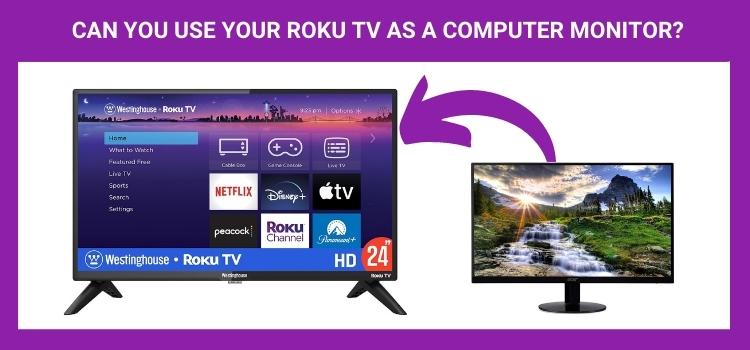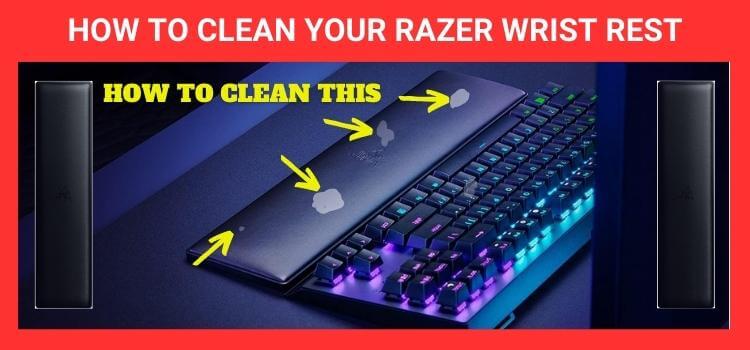As an Amazon Associate I earn from qualifying purchases.

Is a Roku TV Compatible with Computer Displays? Tech lovers who want to get the most out of their gadgets regularly ask this question. The answer is yes, and in this article, we’ll delve into the details of how you can achieve this setup, the advantages it offers, and some essential points to consider.
Can You Use Your Roku TV as a Computer Monitor?
Yes, you absolutely can! Your Roku TV is not just limited to streaming shows and movies; it can also serve as a functional computer monitor. This opens up a world of possibilities, whether working from home, gaming, or wanting a larger display for your tasks.
How to Use Roku TV as a Computer Monitor
Using your Roku TV as a computer monitor is a straightforward process that involves connecting your computer to the TV and adjusting a few settings. Here’s how to do it:
- Check Compatibility: Ensure your Roku TV and computer are compatible with this setup before diving in. Most modern computers and Roku TVs support this feature.
- Connect via HDMI: The simplest method is to connect your computer to the Roku TV using an HDMI cable. Plug one HDMI cable end into your computer’s output and another into an available HDMI port on your Roku TV.
- Adjust Display Settings: Your TV might automatically detect your computer’s display once connected. If not, navigate to your TV’s settings, find the display settings, and select the HDMI input where your computer is connected.
- Resolution and Scaling: Depending on your TV’s resolution, you might need to adjust your computer’s display settings to match. This ensures that the content fits correctly on the TV screen.
How to Connect Roku TV as a Computer Monitor
Connecting your Roku TV as a computer monitor involves more than just the physical connection; you must ensure the devices communicate effectively. Here’s how to combine them seamlessly:
- Power Both Devices: Ensure your computer and Roku TV are powered on before connecting.
- Select the Right HDMI Input: On your Roku TV, select the HDMI input to which your computer is connected. This is usually labeled on the TV or within the input settings.
- Adjust Computer Settings: On your computer, go to the display settings. Depending on your operating system, you may need to extend or duplicate the display. Choose the appropriate option to see your computer’s screen on the TV.
- Display Resolution: Check the display resolution settings on your computer. Adjust the resolution to match your TV’s native resolution for the best visual experience.
How Do You Use Roku TV as a Computer with the Help of Screencasting?
Screencasting, or screen mirroring, is an alternative to connecting your computer to your Roku TV. This wireless approach lets you project your computer’s screen onto the TV. Follow these steps:
- Enable Screen Mirroring: Find the option in the Roku TV’s settings menu. Activate it, please.
- Open Computer Settings: On your computer, access the display settings. Look for the screen mirroring or casting option.
- Connect to Roku TV: Your computer should detect available devices to cast to. Choose your Roku TV from the list.
- Start Screen Mirroring: Once connected, your computer’s screen will appear on the Roku TV. You can now use your TV as an extended display.
How Do You Use a Roku TV as a Computer with the Help of an HDMI Cable?
A well-liked and trustworthy technique to link your Roku TV to your computer is through an HDMI connection. Here’s a step-by-step guide:
- Gather Your Equipment: Make sure you have a long HDMI cable to connect your computer to your Roku TV.
- Connect the HDMI Cable: Plug one end of the HDMI cable into an available HDMI port on your Roku TV and the other end into your computer’s HDMI output.
- Choose the Right Input: Press the input/source button on your Roku TV remote to select the HDMI input linked to your computer.
- Adjust Display Settings: Depending on your computer’s operating system, go to the display settings and choose how your computer’s display will appear on the TV as a mirror or extended display.
Why Should You Consider Using the TV as a Monitor?
Using your Roku TV as a computer monitor may seem intriguing, but is it the right choice? Here are some compelling reasons to consider this setup:
- Larger Screen Real Estate: Roku TVs often have larger screens than traditional computer monitors. This provides a more immersive and spacious workspace for multitasking and creative endeavors.
- Cost-Effective Solution: If you already have a Roku TV, using it as a monitor eliminates the need to invest in a separate computer monitor, saving you money.
- Versatility: Beyond work, you can seamlessly switch between using the TV for entertainment and as a monitor, creating a versatile setup in your space.
Which One Should You Choose – TV or Monitor?
Whether you want to purchase a separate computer monitor or utilize your Roku TV as a display depends on your needs and preferences. Consider the following factors:
- Size: If you value a more prominent display for work and entertainment, using a Roku TV is beneficial. However, a traditional monitor might be more suitable if space is constrained.
- Resolution: Computer monitors often offer higher solutions designed for detailed tasks. A monitor might be the better option if you require precise image quality.
- Purpose: Assess how you intend to use the display. A monitor with fast refresh rates and color accuracy might be more suitable for gaming and design work.
Advantages of a Roku TV as a Computer Monitor
There are many benefits to using a Roku TV as a computer display that supports both work and entertainment:
- Immersive Experience: The large screen size provides an immersive experience, whether working on a project, watching movies, or playing games.
- Simplicity: Using your Roku TV as a monitor involves a few easy steps, so it’s pretty simple.
- Space Efficiency: Combining a TV and a monitor into one device saves space in your home office or entertainment setup.
Benefits of Using a Roku TV as a Computer Monitor
- Ample Screen Real Estate: A Roku TV’s larger display offers more screen real estate, enabling better multitasking and productivity.
- Immersive Entertainment: Enjoy your favorite movies, videos, and games on a bigger, high-resolution screen.
- Cost-Effective Solution: Using your existing Roku TV eliminates investing in a separate computer monitor.
- Wireless Convenience: Some Roku TVs support screen mirroring, allowing wireless connection to your computer.
- Easy Setup: Connecting a Roku TV to your computer is a straightforward process that requires minimal technical knowledge.
Steps to Use Your Roku TV as a Computer Monitor
- Check Compatibility: Ensure your Roku TV and computer have compatible ports (usually HDMI).
- Gather Necessary Cables: Obtain an HDMI cable if not already available.
- Connect Devices: Plug one end of the HDMI cable into the TV’s HDMI port and the other end into your computer’s HDMI output.
- Switch Input Source: On your Roku TV remote, navigate to the HDMI input source connected to your computer.
- Adjust Display Settings: Access your computer’s display settings to configure resolution, orientation, and other preferences.
- Optimize Audio: Depending on your setup, you might need to adjust audio settings on both devices.
Limitations and Considerations
While using a Roku TV as a computer monitor offers numerous benefits, there are some limitations and considerations to keep in mind:
- Input Lag: Roku TVs might have slightly higher input lag than dedicated computer monitors, impacting real-time tasks like gaming.
- Resolution and Refresh Rate: Some Roku TVs may have lower resolution or refresh rates than high-end monitors.
- Text Readability: Text might not appear as sharp on a TV screen due to differences in pixel density.
- Color Accuracy: Color accuracy might not be as precise as on professional monitors designed for graphic design.
- Audio Output: Roku TV speakers might need to provide better audio quality for computer tasks.
Expert Tips for an Optimal Experience
- Use Game Mode: If available, enable the TV’s game mode to reduce input lag during computer usage.
- Adjust Picture Settings: Fine-tune picture settings on the TV to improve text readability and color accuracy.
- External Speakers: Consider connecting external speakers or headphones for better audio quality.
- Screen Mirroring: Explore screen mirroring options for a wireless connection if your Roku TV supports it.
- Keyboard and Mouse: Opt for wireless keyboards and mice to maintain a clutter-free setup.
Conclusion
The answer is a resounding yes—you can use a Roku TV as a computer monitor! This versatile solution opens up possibilities, from boosting your productivity with a larger display to indulging in immersive entertainment during downtime. Following these simple instructions, you can quickly connect your computer to your Roku TV and benefit from a dual-purpose configuration.
Remember, while there are numerous advantages to using a Roku TV as a computer monitor, it’s wise to take note of the limitations, particularly in terms of resolution and refresh rates. Suppose you’re seeking a cost-effective way to enhance your computing experience without compromising entertainment quality. In that case, this solution might be the perfect fit.
So, the next time you ponder, “Can You Use a Roku TV as a Computer Display?” You may affirmatively respond, “Yes, you can!” Embrace the synergy of technology and entertainment that a Roku TV computer setup brings, and elevate your work and play to new heights.
FAQs
Yes, most modern Roku TVs support this feature, allowing you to use them as a computer monitor.
Screencasting offers wireless convenience, allowing you to protect your computer’s screen from the TV without cables.
You can use your Roku TV as a second display in a dual monitor setup, enhancing your productivity.
No, you generally don’t need any special software. Your computer’s built-in screen mirroring functionality should work.
You can switch between using your Roku TV as a computer monitor and streaming content effortlessly.
Related Post
Amazon and the Amazon logo are trademarks of Amazon.com, Inc, or its affiliates.



Leave a Reply